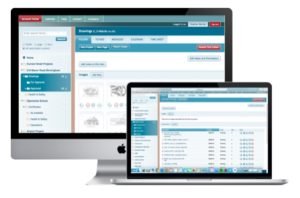If you work in construction, you’ll understand just how important a sophisticated document management system is to get the job done correctly.
Document management systems offer construction companies a whole host of benefits, from better processes and saved time to improved safety and a more informed workforce.
In this article, we explore the three essential best practices in construction document management, and how you can implement them in your organisation.
1. A cohesive structure
Many ‘out-of-the-box’ document management systems come packed with impressive features. However, to get the most out of your software, it’s best practice to set up a cohesive structure so your employees can make the most out of its functionality.
Start by creating a central hub for documentation. Getting off on the right foot can save you loads of hassle trying to reorganise things later down the line, so make some time to set out your structure. Without a clearly communicated destination for document storage, you may find departments storing things in their own way, causing confusion and frustration among colleagues.
To get the structure right, we suggest involving colleagues in this process, so do your research to find out how each department uses the software and build out from there.
Once you’ve launched the new structure, you’ll need to make sure people know about it, so work with any communications or engagement colleagues to promote adoption.
Finally, you’re bound to make a few mistakes in your first attempt, so don’t be afraid to amend things as you go along. If you have some feedback from a certain team or individual, take it on board, test and learn.
2. Ease of access and version control
Ensure that everyone – even remote workers and field-based teams – are able to access your document management system. This is especially important in the construction industry where the majority of the workforce aren’t sitting at a desk all day.
Speaking of remote workers – they’ll have little time to trawl through complicated folder structures, so ensure documents are uploaded correctly, with clear labelling and version control.
It may be worth spending some time developing some guidelines for document storage, so everyone knows the correct way to label and file their documents.
3. Set retention guidelines
The construction industry has strict guidelines on document security and retention.
A well thought out document management system will allow you to set appropriate security measures around certain documents, so only select individuals can access them.
You will also want to think about document retention. Version control is especially important in construction to ensure everyone is looking at the most up to date information. An easy way to manage this is to set expiry dates for documents, so anything out of date simply cannot be viewed.
How Collabor8online can help you
Thankfully, at Collabor8online, we have developed a construction document management system to make your life easier. Share files with your team securely, quickly and easily.
Our familiar Explorer style interface makes it easy for to setup a cohesive folder structure. And with version control and full revision history, you can easily revert to any earlier version of any document, any time. Collabor8online also enables organisations to meet BIM level 2 requirements, being the perfect place to ensure correct construction document management during the design and construction phase, as well as being a repository for important information after completion.
Have you got some document management best practices that you’d like to share? Tweet us @Collabor8online…


